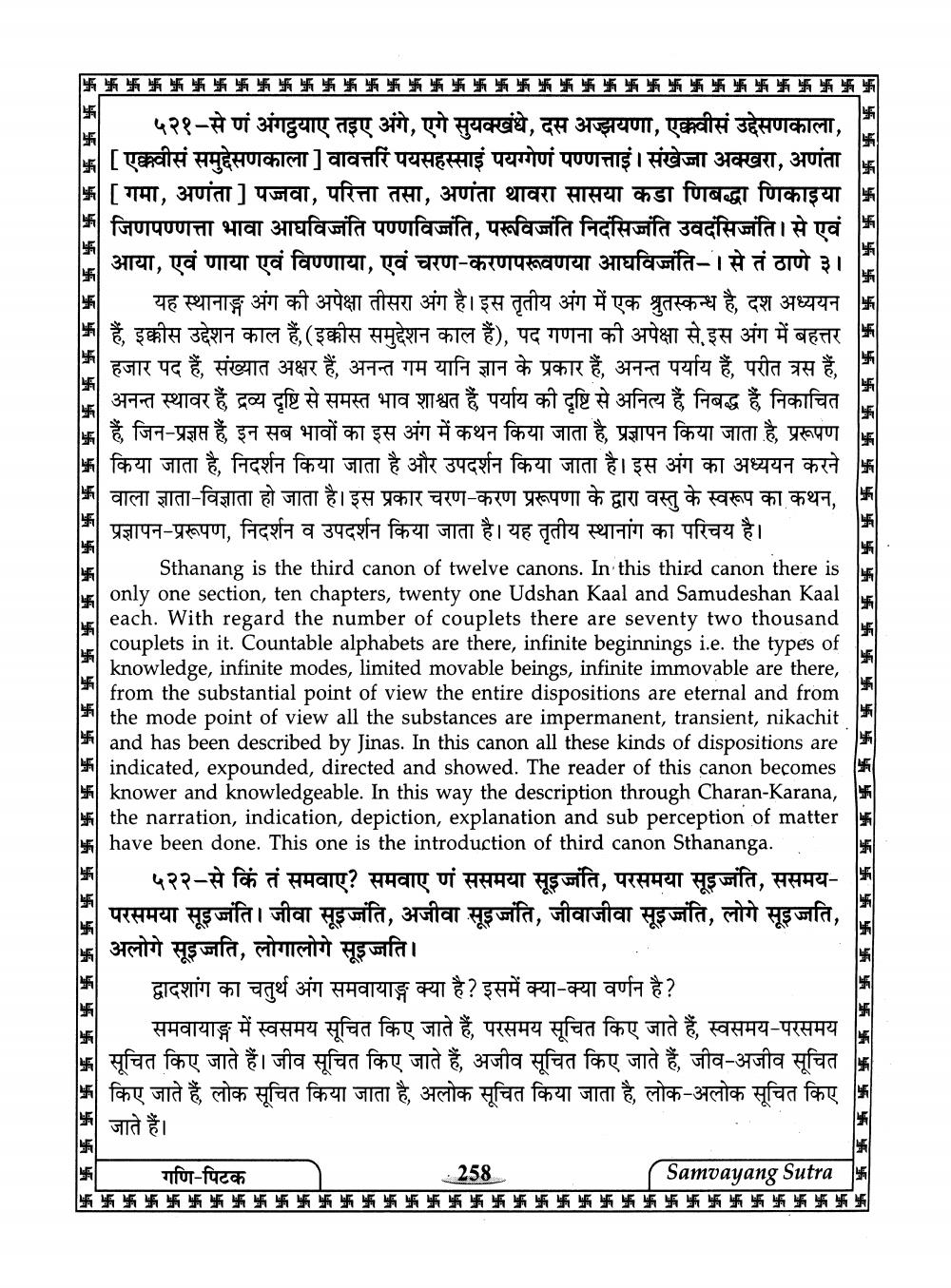________________
当当当当当当当当当当当当当当当当当当%%%%
%%%%% % ५२१-से णं अंगठ्ठयाए तइए अंगे, एगे सुयक्खंधे, दस अज्झयणा, एकवीसं उद्देसणकाला, [एक्कवीसं समुद्देसणकाला] वावत्तरिं पयसहस्साइं पयग्गेणं पण्णत्ताइं। संखेजा अक्खरा, अणंता [गमा, अणंता] पजवा, परित्ता तसा, अणंता थावरा सासया कडा णिबद्धा णिकाइया जिणपण्णत्ता भावा आघविनंति पण्णविनंति, परूविजंति निदंसिर्जति उवदंसिर्जति। से एवं आया, एवं णाया एवं विण्णाया, एवं चरण-करणपरत्वणया आघविजंति-। से तं ठाणे ३।
यह स्थानाङ्ग अंग की अपेक्षा तीसरा अंग है। इस तृतीय अंग में एक श्रुतस्कन्ध है, दश अध्ययन हैं, इक्कीस उद्देशन काल हैं, (इक्कीस समुद्देशन काल हैं), पद गणना की अपेक्षा से, इस अंग में बहत्तर हजार पद हैं, संख्यात अक्षर हैं, अनन्त गम यानि ज्ञान के प्रकार हैं, अनन्त पर्याय हैं, परीत त्रस हैं, अनन्त स्थावर हैं द्रव्य दृष्टि से समस्त भाव शाश्वत हैं पर्याय की दृष्टि से अनित्य हैं निबद्ध हैं निकाचित हैं, जिन-प्रज्ञप्त हैं, इन सब भावों का इस अंग में कथन किया जाता है, प्रज्ञापन किया जाता है, प्ररूपण किया जाता है, निदर्शन किया जाता है और उपदर्शन किया जाता है। इस अंग का अध्ययन करने वाला ज्ञाता-विज्ञाता हो जाता है। इस प्रकार चरण-करण प्ररूपणा के द्वारा वस्तु के स्वरूप का कथन, प्रज्ञापन-प्ररूपण, निदर्शन व उपदर्शन किया जाता है। यह तृतीय स्थानांग का परिचय है।
Sthanang is the third canon of twelve canons. In this third canon there is only one section, ten chapters, twenty one Udshan Kaal and Samudeshan Kaal each. With regard the number of couplets there are seventy two thousand couplets in it. Countable alphabets are there, infinite beginnings i.e. the types of knowledge, infinite modes, limited movable beings, infinite immovable are there, from the substantial point of view the entire dispositions are eternal and from the mode point of view all the substances are impermanent, transient, nikachit and has been described by Jinas. In this canon all these kinds of dispositions are indicated, expounded, directed and showed. The reader of this canon becomes knower and knowledgeable. In this way the description through Charan-Karana, the narration, indication, depiction, explanation and sub perception of matter have been done. This one is the introduction of third canon Sthananga.
५२२-से किं तं समवाए? समवाए णं ससमया सूइजति, परसमया सूइजति, ससमयपरसमया सूइजति। जीवा सूइज्जति, अजीवा सूइजति, जीवाजीवा सूइजति, लोगे सूइज्जति, IF अलोगे सूइज्जति, लोगालोगे सूइज्जति। ___द्वादशांग का चतुर्थ अंग समवायाङ्ग क्या है? इसमें क्या-क्या वर्णन है?
समवायाङ्ग में स्वसमय सूचित किए जाते हैं, परसमय सूचित किए जाते हैं, स्वसमय-परसमय || सूचित किए जाते हैं। जीव सूचित किए जाते हैं, अजीव सूचित किए जाते हैं, जीव-अजीव सूचित । || किए जाते हैं, लोक सूचित किया जाता है, अलोक सूचित किया जाता है, लोक-अलोक सूचित किए ।
जाते हैं।
गणि-पिटक
.258
Samvayang Sutra




